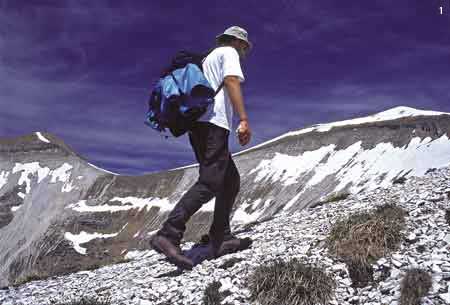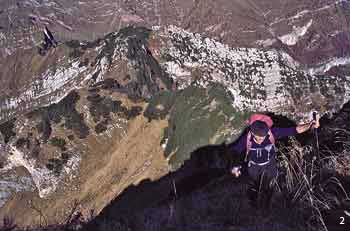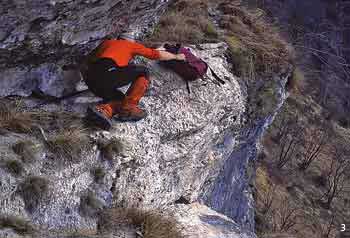| |
ON THE TRACKS OF PIONEERS AND CHAMOIS
Normal routes in the National Park of the Belluno Dolomites
Vittorino Mason
The Book
This work, which took seven years to complete, is a homage to the territory of the National Park of the Belluno Dolomites, which the author chose as his second home.
It is an environment that still has corners of wild nature which are unique in their own way, with rewarding and highly satisfying routes for people that still want to have an adventure looking for their trails, following the footprints of chamois and relying on a few broken twigs and the occasional little stone man.
This guide is the result of a lot of exploring, searches and reconnoitres on the normal routes that lead to many peaks, both inside and on the boundary of the Park.
The normal routes are of modest difficulty for climbers but they involve substantial height differences, sometimes more than two thousand metres and they have challenging approach paths.
The aim of this work, therefore, is to introduce and thus help rediscover the extraordinary and wild environment in the Park with the understanding and respect that it deserves. An adventure, and one with a capital A, is still possible here!
 A fair bit of time has passed since that first route with fixed ropes on the Tofana di Ròzes mountain. I remember that, hapless and hard-up, I went to do the “Lipella” mountain without a harness or helmet and with a pair of training shoes with holes in their soles and that were two sizes too big. Many things have changed since that day but that initial enthusiasm has remained unaltered, and has even grown. After the routes with fixed ropes came the unmarked and less visited paths, then the viàz, the “secondary” peaks, the ones that are not easy to locate, and finally the normal routes, the forgotten ones, where as well as a spirit of quest and exploration it is also necessary to “not do anything”. A fair bit of time has passed since that first route with fixed ropes on the Tofana di Ròzes mountain. I remember that, hapless and hard-up, I went to do the “Lipella” mountain without a harness or helmet and with a pair of training shoes with holes in their soles and that were two sizes too big. Many things have changed since that day but that initial enthusiasm has remained unaltered, and has even grown. After the routes with fixed ropes came the unmarked and less visited paths, then the viàz, the “secondary” peaks, the ones that are not easy to locate, and finally the normal routes, the forgotten ones, where as well as a spirit of quest and exploration it is also necessary to “not do anything”.
Today, looking around me, and reading and listening to the talk in the climbing world, I notice that the majority of young people start off immediately in the mountains with climbing, maybe on famous and difficult routes. You then realise that now nothing remains of the history of the first climbers, of the beauty and the difficulty of the long silent approaches – even with a knowledge of the landscape and the many aspects and terrains of the mountains. Even in the mountains everything wears out early and quickly! Yet, there will also have to be a route to reach the destination, with a wealth of experience behind you to help you along the paths.
We very often forget all about the “easy” trails, , unaware of the surprises and beauty that may be hidden there, like with some normal routes. They’re there for a few mountain lovers. By dusting off some old books and visiting some far-off times with the memory, it is possible to learn about the deeds and exploits of those pioneers, who with a complete sense of adventure and exploration discovered the easiest accesses to reach the mountain peaks. Classic normal routes for the record, old hunters’ trails that still today make things very hard for a lot of people, routes that because of their solitary charm can provoke great excitement and bring back to life like a déjà vu those labours that were then kept and reported in the summit notebooks. 
I like dreaming and venturing along the paths of my memory; I sometimes think I hear the voices of those fearless people swearing about a difficult landscape, the unknown parts of the route and the fear of climbing high, and then the cry of joy when you are in front of the last rock. Well, I also pursue this joy and those uncertainties; the normal routes that are about to be proposed are only a taste in an area of activity, the National Park of the Belluno Dolomites, where I am often out and about, just as if I were one of those pioneers, a hunter who, chasing a chamois, finds the right track to cross a ledge, a path or the route to reach the summit of the mountain.
I am not a writer of guides. This work that took me seven years to complete is a homage to the territory of the park that, out of absolute necessity, I chose as my second home. This is an environment that still has corners of wild nature that are unique of their type. The so praised and sought after Wilderness is here, right on my doorstep. The Monti del Sole, but also the Sahara group, offer rewarding and highly satisfying routes for people that still want to have an adventure looking for their trails, following the footprints of chamois and relying on a few broken twigs and the occasional little stone man. Satisfaction for people that love doing the viàz peaks and climbing on the mixed crumbly terrains with slag, far from the comfortable destinations and ultra-advertised circuits. This guide is the result of a lot of exploring, searches and reconnoitres on the normal routes that lead to many peaks, both inside and on the boundary of the Park. Every trail has been walked between two and six times, so as to give an idea of the difficulty of what has been done. I also wanted to include some mountains just outside the boundaries, because the access trail to these also crosses the Park or because they look towards its interior. Some of the mountains have more climbing routes, but I used my “poetic licence” to propose the ones that I knew or that I liked. Therefore, some of these routes are to be considered “not very normal”. The aim of this guide is to bring together in one single volume a series of routes and peaks already mentioned in other publications, which did not however include the whole territory of the Park.
 Even if these normal routes are of modest difficulty for climbers (only in some cases do they go beyond the III and the IV level) they involve a substantial difference in height that in some cases exceeds two thousand metres, with challenging and selective approach routes. Many of the routes proposed here are not visited very often and others are forgotten, and therefore you are walking on tracks that require experience and knowledge of the territory in order to go forward. Some of these routes are circular, especially on the Monti del Sole, where as well as mountaineering experience it is necessary to be used to moving and climbing in the “air”, on exposed passages, crumbly ground, perhaps with tiny footholds and supports, at times with only mugo pine branches as a rope with an outstretched hand. These are long, tiring and challenging trails from all points of view which require considerable psychophysical preparation. Despite this, the mountains will reserve great satisfaction, emotions and moments that will remain forever in the hearts of all those people that, with the right approach, venture out onto these routes. Even if these normal routes are of modest difficulty for climbers (only in some cases do they go beyond the III and the IV level) they involve a substantial difference in height that in some cases exceeds two thousand metres, with challenging and selective approach routes. Many of the routes proposed here are not visited very often and others are forgotten, and therefore you are walking on tracks that require experience and knowledge of the territory in order to go forward. Some of these routes are circular, especially on the Monti del Sole, where as well as mountaineering experience it is necessary to be used to moving and climbing in the “air”, on exposed passages, crumbly ground, perhaps with tiny footholds and supports, at times with only mugo pine branches as a rope with an outstretched hand. These are long, tiring and challenging trails from all points of view which require considerable psychophysical preparation. Despite this, the mountains will reserve great satisfaction, emotions and moments that will remain forever in the hearts of all those people that, with the right approach, venture out onto these routes.
The aim of this work, therefore, is to introduce and thus help rediscover the extraordinary and wild environment in the Park with the understanding and respect that it deserves. It is an approach and a close examination of the territory intended for those people that understand the value that this natural heritage conserves, also through the effort of reaching the destination. You will find out in this way that adventure, the one with a capital “A”, is still possible and that the mountains are a world where both the body and spirit express themselves.
The author
Vittorino Mason was born in Loreggia (Padua) in 1962. He lives and works in Castelfranco Veneto where he has also carried out for many years the work of a cultural promoter.
He put together a collection of slides La voce dei monti (The voices of the mountains), writes for magazines specialised in mountains and is the coordinator of the Naturalistic Group Le Tracce (The Tracks). He is a member of Mountain Wilderness, and is part of GISM (Italian Group of Mountain Writers).
- 1. The Col di Luna side with Pavióne at the bottom
- 2. Climbing toward Scala’s primary summit
- 3. The exposed ledge soon after Forzèlin
|
|